By: Kyle Wilkinson, Trout's Fly Fishing Marketing and Brand Manager Whether we like it or not- Winter is here. That pretty much gives us two choices- quit fishing, or keep fishing. I’m always of the opinion to ‘keep fishing’. One of the best parts about living in Colorado- and particularly on the Front Range- is the abundance of Tailwater fisheries that lie within an easy drive of our homes. That said, I still believe many anglers aren’t catching as many fish as they should be. If you’ve ever found yourself struggling with your success on winter tailwaters, give these 5 tips a try next time you decide to bundle up and get the boots wet in the months to come:
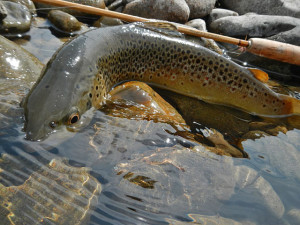 1. Use Yarn- many of you reading this may have heard this recommendation before, but it bears repeating. I feel that strongly about it. Simply put, yarn indicators are WAY more sensitive than plastic bobber-style indicators. Fish this time of year can be pretty lethargic (compared to summer) and typically won’t eat your flies with much aggression. Oftentimes your yarn won’t even dunk underwater but rather just ‘pause’ or ‘lean over’ when a fish strikes. If you’ve never used yarn indicators before, be prepared to be amazed with the sensitivity you’ll get. Side note- tips for yarn success- carry several and liberally apply some fly floatant before starting the day. Be prepared to dry off your indicator every couple hours and reapply. If you decide that your indicator is too waterlogged after a few hours, simply swap it out for a fresh one. While I realize these do require a little more maintenance than a thingamabobber, the fact that it leads to more fish in the net throughout the day is always worth it to me.
1. Use Yarn- many of you reading this may have heard this recommendation before, but it bears repeating. I feel that strongly about it. Simply put, yarn indicators are WAY more sensitive than plastic bobber-style indicators. Fish this time of year can be pretty lethargic (compared to summer) and typically won’t eat your flies with much aggression. Oftentimes your yarn won’t even dunk underwater but rather just ‘pause’ or ‘lean over’ when a fish strikes. If you’ve never used yarn indicators before, be prepared to be amazed with the sensitivity you’ll get. Side note- tips for yarn success- carry several and liberally apply some fly floatant before starting the day. Be prepared to dry off your indicator every couple hours and reapply. If you decide that your indicator is too waterlogged after a few hours, simply swap it out for a fresh one. While I realize these do require a little more maintenance than a thingamabobber, the fact that it leads to more fish in the net throughout the day is always worth it to me.
2. Putty and Split Shot- if you’re not using both split shot AND putty, you’re really missing out. Flows are at their lowest levels of the year and being able to dial in the weight on your nymph rigs is paramount to success. Any of the commercially made tungsten putties will work great so don’t get too caught up on which ‘brand’ to buy. Here’s how I put both split shot and putty to use for me this time of year. To start, select the size of split shot that will get you by in the shallowest water you’ll be fishing. Anytime you come to deeper water, simply pull out a little putty and apply it directly on top of the split shot, rolling it into a nice round ball. Voila. That’s it! Throughout the day you can add and remove putty as necessary to make sure you’re always getting your flies right down into the fishes faces. When you decide you need to take off a little (or all) of the putty you added, simply peel it off and place back in the original container. You can use and reuse tungsten putty for months on end before running out. The best part of using tungsten putty is that it avoids having to constantly pinch and remove split shot throughout the day. This will help protect your light tippets and is also just a whole heck of a lot faster way to make weight adjustments!
3. Never make a cast standing in the water that you could have made standing on dry ground. This is another HUGE one for me, but is a mistake I see anglers make time and time again. 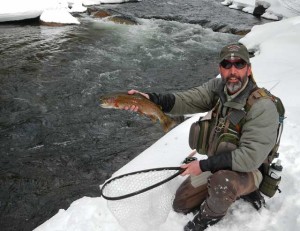 Whenever you approach a likely looking area, always make it a point to fish it while keeping your wading boots on dry ground. Avoiding splashing around, crunching rocks, and in general- disturbing the water with your steps- is always going to leave the fish feeling much more at ease and in turn- more eager to eat your flies (this rule should actually be applied year round).
Whenever you approach a likely looking area, always make it a point to fish it while keeping your wading boots on dry ground. Avoiding splashing around, crunching rocks, and in general- disturbing the water with your steps- is always going to leave the fish feeling much more at ease and in turn- more eager to eat your flies (this rule should actually be applied year round).
4. Tighten up your flies- If you don’t fish your flies spaced closely together during winter, I’m confident you’re missing out on a few fish throughout the day. I always like to say that a wintertime tailwater trout lives in a shoebox. (i.e. if you put a trout in a shoebox, it doesn’t have much room to move side to side). If I’m not getting my flies in this ‘shoebox’ zone, my confidence in getting an eat goes down drastically. My rule for spacing my flies during winter is to make a fist, and then extend my thumb and pink in opposite directions. This is the spacing you should be using- approximately 10” or so. If you’ve never fished your flies this close together, consider yourself warned- it’s probably going to seem a little weird at first. One thing I can promise you though is that you’re going to need your net more throughout the day if you give it a try!
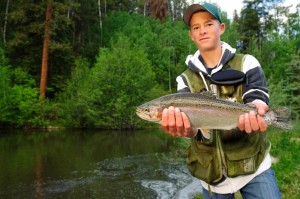 5. Watch the bubbles- we’ve already talked about indicators and weight, and I firmly believe that one of the biggest reasons people don’t catch as many fish as they should is that they’re simply not getting down to them. Next time your nymphing make sure to keep an eye on the bubbles on the surface. What are they doing? Are they moving the same speed as your indicator? If so, this is a dead giveaway you’re not getting down to the fish. Most fish this time of year are sitting very close to the bottom. The water on the bottom of the river is moving slower than the water on the surface. If you’re indicator is floating the same speed as the bubbles on the surface, this means that you’re not getting down to the fish. Simple as that. The goal is to always have your indicator floating SLOWER than the bubbles on the surface. This can quickly be achieved by adding a little more depth and/or weight to your rig. If you’ve never paid attention to this before I think you’ll be amazed at how much of a difference it makes and how quickly you are now able to dial in your rig, ultimately achieving a perfect drift to the fish!
5. Watch the bubbles- we’ve already talked about indicators and weight, and I firmly believe that one of the biggest reasons people don’t catch as many fish as they should is that they’re simply not getting down to them. Next time your nymphing make sure to keep an eye on the bubbles on the surface. What are they doing? Are they moving the same speed as your indicator? If so, this is a dead giveaway you’re not getting down to the fish. Most fish this time of year are sitting very close to the bottom. The water on the bottom of the river is moving slower than the water on the surface. If you’re indicator is floating the same speed as the bubbles on the surface, this means that you’re not getting down to the fish. Simple as that. The goal is to always have your indicator floating SLOWER than the bubbles on the surface. This can quickly be achieved by adding a little more depth and/or weight to your rig. If you’ve never paid attention to this before I think you’ll be amazed at how much of a difference it makes and how quickly you are now able to dial in your rig, ultimately achieving a perfect drift to the fish!
Trouts Fly Fishing is a full service fly shop located in the heart of Denver, CO between Downtown and Cherry Creek North. A second location was established in Frisco, CO located right on Main St. In addition to selling fly fishing goods, Trouts also offers a wide selection of fly fishing classes, guided trips and destination travel options. Some of their trips include both float fishing and wade fishing on the Blue River, Colorado River, Williams Fork River, Eagle River, Roaring Fork River, Frying Pan and Arkansas River. Trouts has been proudly serving the angling community for over 15 years.






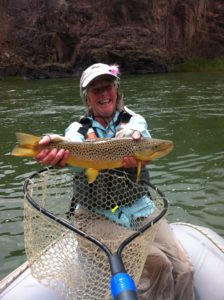 Why did you become a member and what chapter are you involved with?
Why did you become a member and what chapter are you involved with?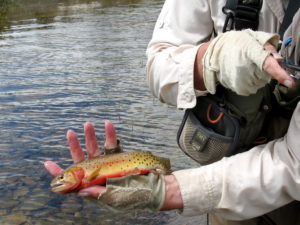
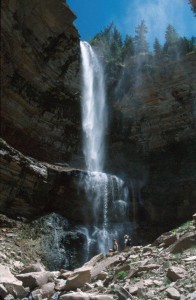

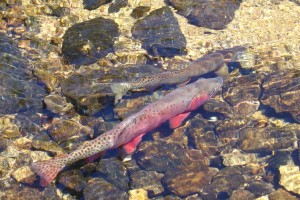
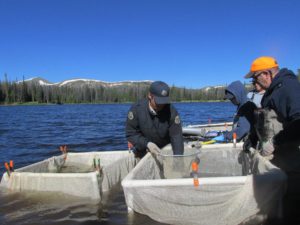 Colorado TU teamed up with Colorado Parks and Wildlife to reintroduce Greenback Cutthroat trout into their native watersheds all along the Front Range. Efforts this past year including spawning
Colorado TU teamed up with Colorado Parks and Wildlife to reintroduce Greenback Cutthroat trout into their native watersheds all along the Front Range. Efforts this past year including spawning 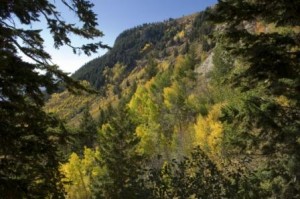
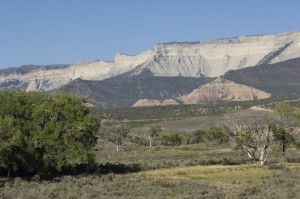 The MLP process is a new tool that promises to address some of that top-down, fragmented approach to public land management. To their credit, the BLM is listening and incorporating suggestions from local ranchers, conservation groups and elected officials into their leasing plan for South Park.
The MLP process is a new tool that promises to address some of that top-down, fragmented approach to public land management. To their credit, the BLM is listening and incorporating suggestions from local ranchers, conservation groups and elected officials into their leasing plan for South Park.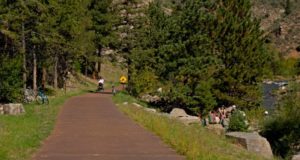 The trail includes not only 3 miles of a paved multiuse trail, but features 3 bridges, 6 new formal river access points and multiple overlooks and boulder seating areas. Other improvements include two new parking lots and an expanded parking lot and restroom at Mayhem Gulch. The parking lots are a key component to bringing a new types of visitor to Clear Creek Canyon; cyclists, hikers and walkers.
The trail includes not only 3 miles of a paved multiuse trail, but features 3 bridges, 6 new formal river access points and multiple overlooks and boulder seating areas. Other improvements include two new parking lots and an expanded parking lot and restroom at Mayhem Gulch. The parking lots are a key component to bringing a new types of visitor to Clear Creek Canyon; cyclists, hikers and walkers.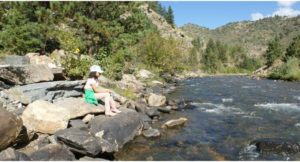 t was encouraging to see extended families walking the trail, leaning over the guardrail at an overlook pointing to trout rising behind a large boulder. Joggers pushing strollers paused at the overlooks on the bridges to catch their breath. Cyclists were numerous and one group took advantage of the informal boulder seating areas to stop for a picnic lunch. There were crowds of climbers at all of the popular areas, and fisherman were ducking in and out of the willows along the banks.
t was encouraging to see extended families walking the trail, leaning over the guardrail at an overlook pointing to trout rising behind a large boulder. Joggers pushing strollers paused at the overlooks on the bridges to catch their breath. Cyclists were numerous and one group took advantage of the informal boulder seating areas to stop for a picnic lunch. There were crowds of climbers at all of the popular areas, and fisherman were ducking in and out of the willows along the banks.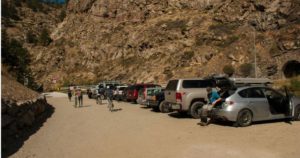 My overall impression of the trail was extremely positive. The materials used through compliment the character of the Canyon. The improved parking areas provide additional spaces and greatly improve visitor safety and the new signage is clear and concise. The biggest improvement; however, is the trail. It allows visitors to disconnect from Highway 6 and truly immerse themselves in the Creek, the Canyon, and the Landscape.
My overall impression of the trail was extremely positive. The materials used through compliment the character of the Canyon. The improved parking areas provide additional spaces and greatly improve visitor safety and the new signage is clear and concise. The biggest improvement; however, is the trail. It allows visitors to disconnect from Highway 6 and truly immerse themselves in the Creek, the Canyon, and the Landscape.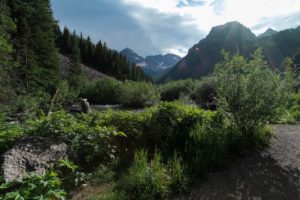 We have always prided ourselves on our ability to work in a bipartisan manner. Since Trout Unlimited was founded in Michigan in 1959, the organization has existed—and grown—through 11 different presidential administrations (29 years Republican, and 28 years Democrat). For example, several clear opportunities exist for us in the new Congress and with the new Trump Administration; these include Good Samaritan legislation to help clean up abandoned mines, a higher priority on water infrastructure improvements, and public land renewable energy legislation.
We have always prided ourselves on our ability to work in a bipartisan manner. Since Trout Unlimited was founded in Michigan in 1959, the organization has existed—and grown—through 11 different presidential administrations (29 years Republican, and 28 years Democrat). For example, several clear opportunities exist for us in the new Congress and with the new Trump Administration; these include Good Samaritan legislation to help clean up abandoned mines, a higher priority on water infrastructure improvements, and public land renewable energy legislation.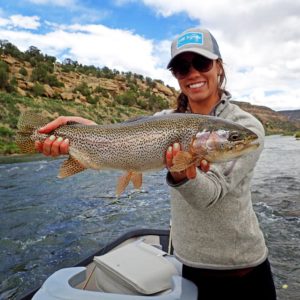
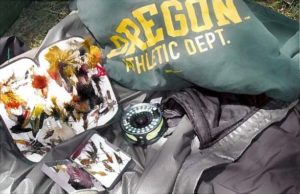 I was a TU member before I ever belonged to a chapter. I supported TU because I liked it's message and I liked to fish, and I'd like to think of this sport and this pleasure being here for those that come next.
I was a TU member before I ever belonged to a chapter. I supported TU because I liked it's message and I liked to fish, and I'd like to think of this sport and this pleasure being here for those that come next.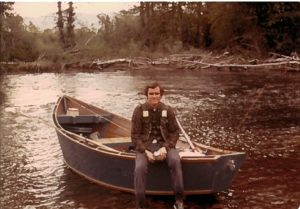
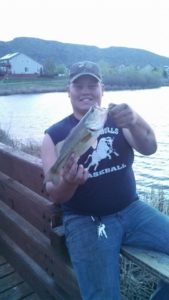 The CTU camp that I was lucky to attend in my freshman summer going into high school was one of the best experiences that I have ever had. I really do think it was one of my best fishing experiences ever. I was able to share a common interest with everyone that I was fortunate to meet. I was able to share not only the amazing hobby of fishing but to help out and better the life of not only me but the fish and future fishermen and women. While I was there I shared many experiences and moments that I will treasure through my whole life. One moment that I remember clear as day was the chance to be one with the water and look to what fish refer to as, food. I was able to clearly see and extract many bugs in a stream that was abundant of fish. It was also a very humbling experience because I was able to see how we as a youth group could really impact the future of fishing and to ensure the maintenance to keep our fishing in Colorado going strong. I am very grateful of what I was able to learn in the short amount of time I was there. I would have been okay if it was all summer but I still am very grateful for the chance to attend an amazing camp full of amazing people.
The CTU camp that I was lucky to attend in my freshman summer going into high school was one of the best experiences that I have ever had. I really do think it was one of my best fishing experiences ever. I was able to share a common interest with everyone that I was fortunate to meet. I was able to share not only the amazing hobby of fishing but to help out and better the life of not only me but the fish and future fishermen and women. While I was there I shared many experiences and moments that I will treasure through my whole life. One moment that I remember clear as day was the chance to be one with the water and look to what fish refer to as, food. I was able to clearly see and extract many bugs in a stream that was abundant of fish. It was also a very humbling experience because I was able to see how we as a youth group could really impact the future of fishing and to ensure the maintenance to keep our fishing in Colorado going strong. I am very grateful of what I was able to learn in the short amount of time I was there. I would have been okay if it was all summer but I still am very grateful for the chance to attend an amazing camp full of amazing people.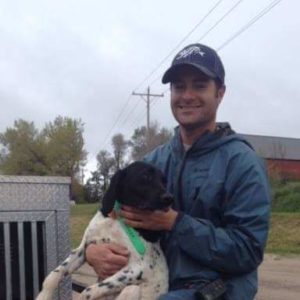 Many of the leaders and volunteers involved in the CTU Youth Camp have originated from the University of Colorado fly fishing club. The CU Fly Fishing Club is a wonderful fly fishing group that is part of the University of Colorado club sports program. The club focuses on teaching the art of fly fishing, fly casting and fly tying to all experience levels and is a place where anglers can share fishing information and form life long friendships.
Many of the leaders and volunteers involved in the CTU Youth Camp have originated from the University of Colorado fly fishing club. The CU Fly Fishing Club is a wonderful fly fishing group that is part of the University of Colorado club sports program. The club focuses on teaching the art of fly fishing, fly casting and fly tying to all experience levels and is a place where anglers can share fishing information and form life long friendships.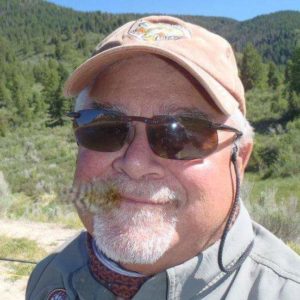 Our campers have gone on into careers in science, law, engineering and other pursuits. Because I have stayed in touch with many of them over the years, I know that our graduates not only continue to enjoy fly fishing, they maintain their interest in river conservation and many participate in Trout Unlimited projects and in TU chapter activities. One young man has started a TU chapter at his university and has thus involved many other young people in TU conservation projects and fly fishing. One of our campers returned several times as a youth counselor; she’s now a full-fledged adult volunteer member of our staff. Another was on the USA National Youth Fly Fishing Team that won a world championship. This program works.I’ve been involved in youth programs with my local TU chapter, St Vrain Anglers, and with CTU’s Youth River Conservation and Fly Fishing Camp; this will be my ninth year as a counselor at the CTU Camp. In that time I’ve seen nearly 200 teens from all over Colorado come through the program. They’ve ranged from hip Denver kids to dyed-in-the-wool ranch and farm kids and everything in between. One thing they have had in common is a love of being outdoors, learning something about the environment, and a desire to protect it.
Our campers have gone on into careers in science, law, engineering and other pursuits. Because I have stayed in touch with many of them over the years, I know that our graduates not only continue to enjoy fly fishing, they maintain their interest in river conservation and many participate in Trout Unlimited projects and in TU chapter activities. One young man has started a TU chapter at his university and has thus involved many other young people in TU conservation projects and fly fishing. One of our campers returned several times as a youth counselor; she’s now a full-fledged adult volunteer member of our staff. Another was on the USA National Youth Fly Fishing Team that won a world championship. This program works.I’ve been involved in youth programs with my local TU chapter, St Vrain Anglers, and with CTU’s Youth River Conservation and Fly Fishing Camp; this will be my ninth year as a counselor at the CTU Camp. In that time I’ve seen nearly 200 teens from all over Colorado come through the program. They’ve ranged from hip Denver kids to dyed-in-the-wool ranch and farm kids and everything in between. One thing they have had in common is a love of being outdoors, learning something about the environment, and a desire to protect it.
